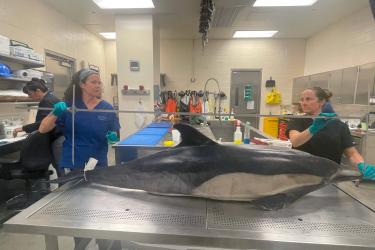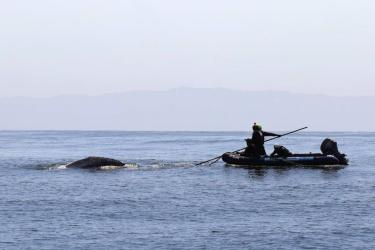Where have you been all these years?
That's a question scientists have been asking sea turtles for a long time. After the turtles hatch and waddle into the sea, they're pretty much off the radar until they turn up as juveniles on beaches that might be half a world away. But thanks to new technology, scientists are finally getting some answers.
One of those new technologies involves skeletochronology. "Just like trees have annual rings, so do the bones of sea turtles," said Cali Turner Tomaszewicz, a scientist at NOAA's Southwest Fisheries Science Center in La Jolla, California. "And you can analyze those rings to get all kinds of information about the animal's life history."
The rings are most visible in the humerus bones, which form the upper arms of humans but in sea turtles are found in the flipper. Turner Tomaszewicz collects the bones from the bodies of sea turtles that are found dead on beaches in Northern Mexico and California. She works mainly with Eastern Pacific green turtles and North Pacific loggerheads, both of which are listed as endangered under the Endangered Species Act.
"The animal does have to be dead for us to get at this data," Turner Tomaszewicz said. "Even though their death is unfortunate, we can still learn something from them afterwards."
After collecting a humerus bone, Turner Tomaszewicz brings it to the lab and, using a high-precision, diamond-studded circular saw, cuts two adjacent cross sections, each exactly 3 millimeters thick. "They look like wooden nickels," Turner Tomaszewicz said.
She also cuts a 25-micron-wide slice at the same location and stains it with dye that makes the annual rings visible. Using the stained slice as a blueprint, she then programs a computer-driven micro-drill to extract tiny tissue samples from the thicker slices, with each sample coming from a different annual ring.
Chemical Signatures Reveal an Animal’s History
You are what you eat, and so the chemical composition of each annual ring reflects the animal's diet during that year of its life. North Pacific loggerheads, for instance, start life in the Pacific Ocean after hatching on beaches in Japan. They eventually cross the Pacific to spend their juvenile years near the coast of Southern California and Baja California in Mexico. Those different environments leave distinct chemical traces in the annual rings.
Turner Tomaszewicz analyzes the tissue in each ring using a technique called stable isotope analysis. That technique is based on the fact that chemical elements, including nitrogen, carbon, and oxygen, come in two varieties: heavy and light. Conveniently for scientists, the near-shore environment is richer in heavy nitrogen than the open ocean, and that difference shows up in the tissues of the animals that live there.
"By analyzing the annual rings, we can see during what years a turtle was in its oceanic phase and at what age it settled into its near-shore habitats." And this analysis has yielded some surprising results. It turns out that loggerheads spend up to two decades—much longer than previously thought—off the North American coast before returning to their nesting beaches in Japan.
Scientists have also recently started tracking baby sea turtles using satellite tags, which give precise information on an animal’s whereabouts. But the tags usually fall off after several months. Isotopic analysis gives less precise location data, but covers a greater time period.
"By analyzing the skeletal tissue, we get a very refined retrospective view of an animal's ecology in each year of its life," said Jeff Seminoff, who heads the Marine Turtle Ecology and Assessment Program at NOAA's Southwest Fisheries Science Center. "That allows us to prioritize protection efforts in the habitats that are most important to these species."


